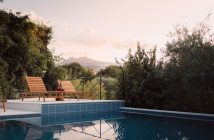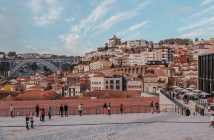In the first of a three-part travel special, as we enter the final furlongs before Christmas, Harry Chapman ventures to Israel and discovers the historic port of Acre…
Israel. Land of Milk and Honey. The Promised Land. The Holy Land. Birthplace of Christ. It is a place that means different things to many different peoples. It is a gateway to the east, and also a gateway to the west, a land that combines qualities of both but is somehow neither. Situated on the eastern shores of the Mediterranean, it contains deserts, mountains, inland seas and fertile river valleys. It also has an extraordinarily long and rich history and a mixture of cultures born out of passing and conquering nations. In many ways, Israel has it all.
It is also a country that provokes strong reactions. It is almost impossible to remain neutral or to be free of opinion when considering Israel. I had been once before, albeit briefly, on my way to the West Bank to shoot a documentary for a disabled children’s charity. Then I had experienced the other side, as it were – the wall, watchtowers, Israeli settlements and the poverty of the local population. Now I was back with a very different agenda – cultural rather than humanitarian.

The centrepiece of the trip was Acre, or Akko as it is now called. This caused me great excitement as I knew it from my school books to have been a major Crusader stronghold and still preserved the romantic notion that it was a site of chivalry and derring do. And I was not the only one. Amongst the many thousands of pilgrims and religionists who yearly descend on the country there is a comparable number of antiquarians and amateur historians. For the medievalist, Akko continues to be a star draw.
With my Western-centric education, what I hadn’t appreciated was that Akko’s turn as a Crusader bastion remained a tiny fragment of its long and venerable history. It has been occupied and ruled variously by the Canaanites, the Israelites, the Greeks, Persians, Romans, Arabs, Crusaders, Ottomans, British and once again by the Israelites, or more accurately, the modern State of Israel. Founded as an urban settlement in the Middle Bronze Age nearly four thousand years ago, Akko ranks as one of the oldest continuously inhabited cities in the world.
We arrived in Tel Aviv under the cover of darkness which is always disconcerting – no natural light to reveal one’s environment, no obvious features with which to orientate oneself. We were immediately whisked away by car and the big six lane highway, concrete embankments, twinkling city lights in the distance and the glass fronted bars of the town of Nahariya when we arrived were so uniformly homogenous that I could have been in any one of the countries I had visited in the last few years – Tenerife, Portugal, Albania. I was surprised to discover, on breakfasting the next morning at our hotel, the boutique Shtarkman Erna, that the sea was only a few hundred yards away.
 We were going north as Akko sits at the top of the country, not far from the border with Lebanon. It was here that it had occupied a strategically important position, guarding both the land trade routes north, south and east, cutting across the Plain of Esdraelon, as well as the shipping routes that ran west across the Mediterranean. With its deep natural harbour, one of the very few along the coast of Israel, nestled in the horseshoe of the Bay of Haifa which breaks the clean scimitar sweep of the Israeli coastline, Akko was the gateway to the Levant.
We were going north as Akko sits at the top of the country, not far from the border with Lebanon. It was here that it had occupied a strategically important position, guarding both the land trade routes north, south and east, cutting across the Plain of Esdraelon, as well as the shipping routes that ran west across the Mediterranean. With its deep natural harbour, one of the very few along the coast of Israel, nestled in the horseshoe of the Bay of Haifa which breaks the clean scimitar sweep of the Israeli coastline, Akko was the gateway to the Levant.
So much for my visions of blistering eastern skies and pellucid seas – with a week to go before Christmas, the weather seemed to have followed me from Blighty – a fierce wind drove in from the Bay of Haifa, churning the sea and skittering sand across the road. Both sky and sea were grey, as grey as the English Channel. It was cold and the black asphalt of the car park was slick with recent rain.
Unlike the Crusader princes though, we approached not from the seas, but from the land, and from the south. Like nearly every present day urban settlement, we had to pass through a swathe of ugly accretions to get to the urban ore. But to be fair there was not much if it. In fact I was surprised at how small Akko felt. There are 47,000 inhabitants today. In the 1130s, when the Crusader kingdom of Jerusalem was in full swing, there were about 25,000. Small by today’s standards and less than half of the current population, but at a time when most people lived in villages, this must have felt like quite a metropolis.
As we made our way through old Akko I was confused. With its packed streets and crumbling walls this was certainly an ancient place but I was expecting to see a snapped off piece of European medievalism, with echoes of the mighty fortress of Krak des Chevaliers which the Knights Hospitallers built in the highlands of Syria. Despite its whiff of age, Akko was disappointingly Eastern in appearance.

The Siege of Acre by Dominique Papety (circa 1840)
Wandering across to the sea front we looked forlornly at the remains of the Templar fortress which was so reduced that it resembled little more than the granite convulsions of nature, wherein a gaping breach the water sucked at the rounded stones that are left. Where was medieval Akko? Had I travelled three thousand miles for this?
Akko was sacked by the Mameluks in 1291, ending two hundred years of Crusader rule. The city was raised to prevent the return of the Christians and its use as a military base. Still, even in ruins it must have been a comfortable place as thirty years later a local Syrian geographer noted that it was “a beautiful city” and full of artisans.
It was the Ottomans who put paid fully to the memory of Crusader Acre. They took control of the city two hundred years later. It continued to moulder away for a couple of centuries before its status was revived in the eighteenth century. Except that the local sultan, a brutal man nicknamed the Butcher, chose not to rebuild what was there but to bury it in rubble and start from scratch. Crusader Acre was gone.
Except it wasn’t. The sultan’s act of cultural vandalism inadvertently preserved it. In the 1970s a burst water pipe lad to the discovery and subsequent excavation of a whole complex of halls, many built by the Knights Hospitallers, including the monumental vaulted refectory and the Templar Tunnel running underground from their seaboard fortress for the safe ferrying of gold. In fact there is a vast imprint of streets, vaults and crypts still extant under street level which gives a fascinating glimpse into life in Acre nearly one thousand years ago.

Many of these are open to the public with attendant audio guides but such is the pregnant atmosphere of these chambers that it is quite nice to drift about with nothing but the echo of footsteps and the occasional murmur of running water from the underground stream. Tantalisingly only about a fifth of the city has been subject to excavation, the rest, under densely packed housing, has been deemed to hold too high a risk of collapse.
The bulk of Akko, that which is visible to the eye – the fortress, the impressive Khan al-Umdan or the Inn of the Columns (built for the unloading of merchant ware and the housing of these travellers, but closed for renovations when we were there) the remaining city and sea walls – is all eighteenth and nineteenth century Ottoman. But even this, the newest of architectural interloper, is in a fragile state.
We visited an eighteenth century merchant’s home which was being restored by a local conservation society who organised school children from around Europe to come and help in the process. I was moved by their energy and enthusiasm. The house, with it half galleried first floor hall and the remnants of painted walls and ceilings, must have been gorgeous in its day but was now in a parlous state. Yet without good people like this how quickly all this could be lost.
Harry’s adventures in the Holy Land continue next weekend as he discovers Acre’s significance to the Bahá’í religion, and samples the delights of Israeli cuisine…




